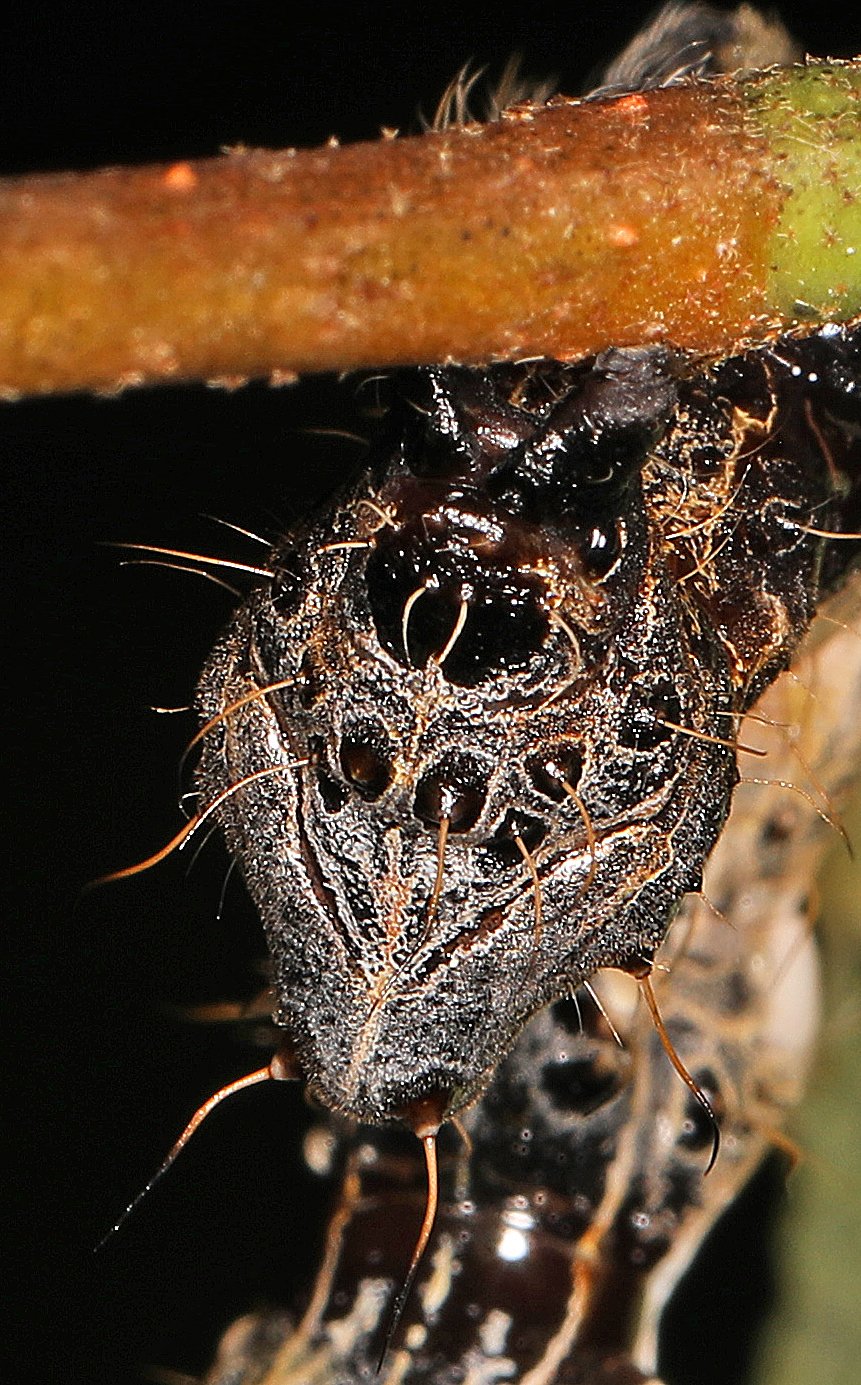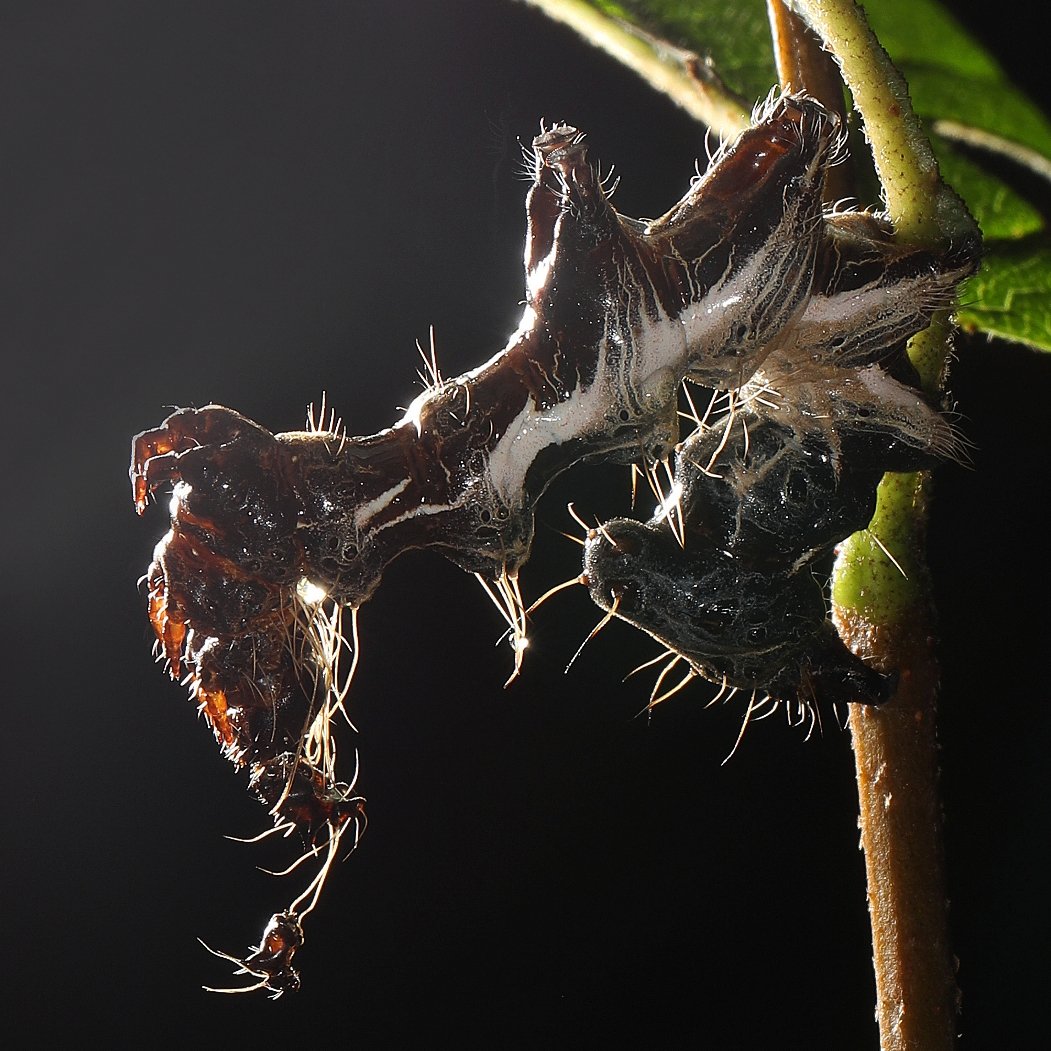Photo: Wavy-lined Emerald Moth caterpillar, Judy Gallagher
Judy Gallagher is an ASNV board member and a regular surveyor of local wildlife who also captures photos of what she sees, in particular the less common species.
I was thrilled to find a Harris's Three-spot caterpillar recently, which inspired this month's column on a few caterpillar defense strategies.
The main purpose of a caterpillar is to eat constantly to store enough energy to transform into its adult shape, and then reproduce. Because a caterpillar can't fly away to escape predators, it needs to have ways to avoid being eaten.
White-blotched Heterocampa caterpillar, Judy Gallagher
If a caterpillar matches its surroundings, perhaps the predator won't notice it. This White-blotched Heterocampa caterpillar (above) blends in well with the leaf it is on. Not only does the green color match the leaf, but the white splotches break up the outline of the caterpillar and look like leaf blemishes.
Eastern Tiger Swallowtail caterpillar with Osmeteria , Judy Gallagher
Another way to avoid being eaten is to look like something unappetizing. Early instar Eastern Tiger Swallowtail caterpillars look like bird poop. Most predators don't want to eat bird poop and thus avoid eating the well-disguised caterpillar. This caterpillar is also showing another defense mechanism, its osmeteria, the yellow "horns" at the right of this picture. This is a defensive organ that is normally hidden, but is exposed when the caterpillar is threatened. It emits a foul, disagreeable odor that repels ants, small spiders, and praying mantises. The only species that have this organ are Swallowtail butterflies.
Eastern Tiger Swallowtail caterpillar , Judy Gallagher
As the caterpillar grows, it gets too big to look like bird poop, so later instar Eastern Tiger Swallowtail caterpillars have markings that resemble snake eyes. When a predator approaches, the caterpillar inflates the front of its body so it looks like a snake head. The eye spots are fairly large, which makes the caterpillar appear larger than it really is.
Wavy-lined Emerald Moth caterpillar, Judy Gallagher
Some caterpillars work quite hard to disguise themselves. The decorator caterpillar, the larva of the Wavy-lined Emerald Moth, uses plant material as camouflage. It attaches the plant material to itself using silk that it excretes, and replaces its camouflage on a daily basis. It also replaces its camouflage if it moves to a different flower species.
Milkweed Tussock Moth caterpillar, Judy Gallagher
The Milkweed Tussock Moth caterpillar protects itself by ingesting milkweed plant toxins, rendering it unpalatable to birds. This caterpillar is brightly colored which typically alerts predators that it doesn't taste good. The "hairs" on the caterpillar can cause an unpleasant rash, an additional defense.
Harris's Three-spot caterpillar looking like a spider, Judy Gallagher
The Harris's Three-spot caterpillar has a couple of particularly interesting defense mechanisms. From behind, it looks like a Jumping Spider, which keeps some predators from attacking the caterpillar.
Harris's Three-spot caterpillar with head capsule, Judy Gallagher
The caterpillar resembles dirt and old cobwebs, which further protects it from predation. But most bizarre, Harris's Three-spot keeps its old discarded head capsules after it sheds its skin and attaches them to the long white hairs on its head. When a potential predator like a wasp, bird or a photographer approaches, the caterpillar whips the head capsules back and forth with surprising rapidity and accuracy. The head capsule is seen at the bottom left of this picture.
There are many other caterpillar defenses, including several butterflies and moths that fling their poop some distance to confuse wasps that locate their prey by the smell of the excrement. I am constantly amazed by the lengths to which species go to avoid being eaten.
View more of Judy’s Observations from Meadowood articles here.








